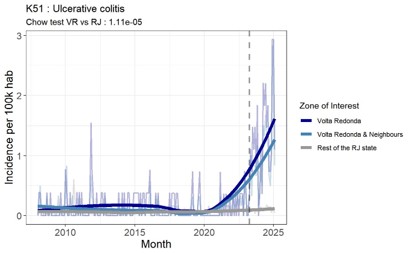Real World Evidence: eXp AI-driven Assessment of Air Pollution Impact on Human Health: Global Health Assessment-A Volta Redonda Case Study
Overview
Ariana Pharmaceuticals conducted a retrospective cohort study on 1.9 million hospital admission records from the Rio de Janeiro (RJ) State using hospitalized records from the Brazil’s DataSUS database, using the Ariana RWD cloud platform and KEM® Explainable AI to evaluate the health impact of air pollution and industrial activity in Volta Redonda, a city known for its large iron and steel industry.
The study, part of a Proof-of-Concept (PoC) initiative, applied time series breakpoint detection, machine learning, and smart dashboards to explore disease incidence patterns associated with environmental exposure and to identify vulnerable population subgroups.
Impact
The study demonstrates the power of explainable AI to extract clinically interpretable insights from massive national health databases. By integrating and consolidating geospatial, demographic, and clinical data in a dedicated RWD cloud platform, Ariana’s approach identified 13 diseases with higher incidence in Volta Redonda and neighboring cities –7 of which have published evidence linking them to air pollution exposure.
Key outcomes include:
The primary objective of the study was to identify genomic biomarkers associated with increased mortality in toxic liver disease, which could serve as predictive indicators of liver toxicity risk in drug-exposed populations.
Secondary objectives included:
-
- ● Quantification of excess hospital admissions and direct healthcare costs (2023–2025) that could be attributed to air pollution. (ICD-10 K71).
- ● Identification of high-risk subgroups by age, sex, and race through demographic stratification.
- ● Time series breakpoint analysis indicating recent accelerations in disease incidence, potentially influenced by post-COVID-19 inflammatory effects.
- ● Creation of interactive smart dashboards for dynamic exploration of data and trends.
These findings pave the way for integrating AI-based environmental health analytics into policymaking and preventive care initiatives in other regions exposed to potential industrial and environmental changes
Objective
The primary objective was to evaluate the association between industrial air pollution and hospitalization rates in Volta Redonda using a scalable, explainable AI framework. Secondary objectives included:-
- ● Identifying diseases disproportionately represented in Volta Redonda compared to other municipalities in Rio de Janeiro State. (ICD-10 K71).
- ● Characterizing patient subgroups affected by these diseases.
- ● Detecting time-dependent breakpoints to assess recent changes in disease incidence and healthcare burden.
Method
Data Source: 1.9 million hospital admission records (2008–2025) from DataSUS, Brazil’s national public health database, consolidated into Ariana’s cloud-based analytics platform containing over 12 billion records. Analysis Tools: KEM® Data Science platform, time series breakpoint detection, and interactive dashboards.Key Steps
-
-
- 1. Data Integration:
-
- 2. AI-Based Analysis (KEM®): The KEM® explainable AI engine identified statistically significant associations between residence zones and diseases using association rule mining.
- ● 6,422 rules identified.
- ● 13 ICD-10 codes showed higher incidence in Volta Redonda and its neighbors: the chance of being affected by corresponding disease show a 50% increase in Volta Redonda as compared to control.
- 3. Time Series Breakpoint Analysis: Interrupted Time Series (ITS/BP) methods detected inflection points (2014–2023), confirming trends and estimating excess admissions and costs linked to detected disease clusters.
- 4.4. Demographic Characterization: Age was divided into six classes (Infant, Child, Adult, Older Adult, Retired), and ethnicity was included to identify population subgroups at elevated risk.






Result
The eXp.AI-driven analysis identified 13 diseases with increased incidence in Volta Redonda and neighboring municipalities. Of these, 7 had previously published links to air pollution, including:- ● C78 – Secondary malignant neoplasm of respiratory and digestive organs.
- ● I21 – Acute myocardial infarction.
- ● I65 – Occlusion and stenosis of precerebral arteries.
- ● K50 – Crohn’s disease.
- ● K51 – Ulcerative colitis.
- ● C78 – Secondary malignant neoplasm of respiratory and digestive organs.
- ● L50 – Urticaria.
- ● M07 – Psoriatic and enteropathic arthropathies.
Time series analysis revealed multiple breakpoints (2014–2023) consistent with rising hospitalization trends. Notably, the post-COVID-19 period corresponded with an accelerated increase in several inflammation-related conditions, supporting the hypothesis that the pandemic may have acted as a trigger in an already polluted area.
Interactive dashboards built on Ariana’s dimensional data model allowed exploration of geographic and demographic patterns, highlighting areas of greatest health burden.


